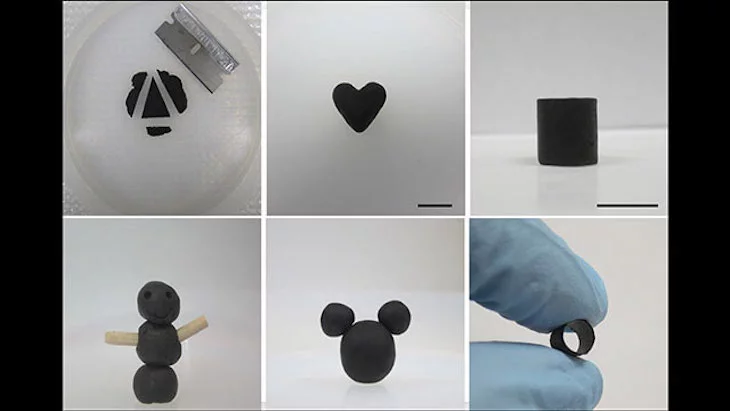There has been a lot said and written about the possibilities of graphene sheets, with their potential to stop bullets, make dirty water drinkable and even as a source of clean energy. But material scientists at Northwestern University are casting their minds towards more malleable forms of the material that can be kneaded and molded like Play-Doh, and can then be hardened into electrically conductive three-dimensional solids of any shape.
The scientists used graphene oxide as their starting point for their new material, which is a form of oxidized graphite consisting of carbon, oxygen and hydrogen atoms and often serves as the building block for graphene itself. As regular readers will know, graphene takes the form of a sheet of carbon with remarkable strength, a very light weight and great electrical conductivity, despite measuring just a single atom in thickness.
While graphene oxide can be converted into doughy materials by adding binding additives to the mix, this then requires additional manufacturing steps to remove the additives once they've done their job. If left in place, they can compromise the wonder material's very desirable properties.
"Adding binders such as plastics could turn anything into a dough state," says Jiaxing Huang, Professor of Materials Science and Engineering at Northwestern University and lead author of the study. "But these additives often significantly alter the material's properties."
Huang and his team found another way of turning graphene oxide into something malleable, and it involved simply adding water to highly concentrated forms of the material. This approach not only produces Play-Doh-like graphene in fewer steps, it can also make storing and transporting it safer and more efficient.
"Currently graphene oxide is stored as dry solids or powders, which are prone to combustion and explosion," says Huang. "Or they have to be turned into dilute dispersions, which multiply the material's mass by hundreds or thousands."
The resulting material, which the scientists have dubbed "GO dough", can be molded and kneaded into various forms and readily reshaped if need be. These can then be turned into dense solids capable of conducting electricity, remaining chemical stable and mechanically hard. Further processing, the team says, can see it turned into different forms of customizable graphene with tunable microstructures.
"My dream is to turn graphene-based sheets into a widely accessible, readily usable engineering material, just like plastic, glass and steel," Huang says. "I hope GO dough can help inspire new uses of graphene-based materials, just like how play dough can inspire young children's imagination and creativity."
The research was published in the journal Nature Communications.
Source: Northwestern University




